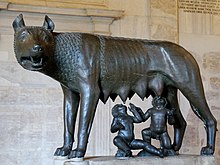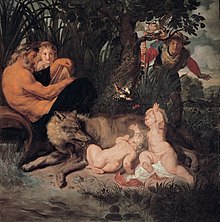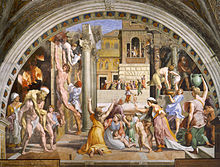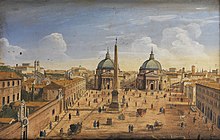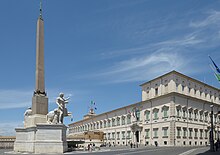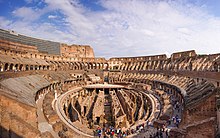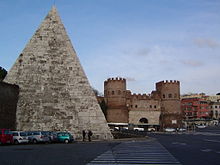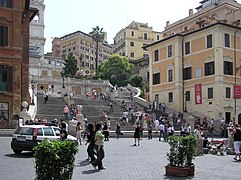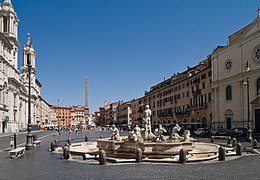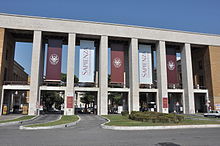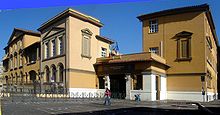Rome
Rome is an Italian city, capital of the Lazio region and of Italy. With a population of 2,857,321 inhabitants, it is the most populous municipality in Italy and the third most populous city in the European Union. known since Antiquity as the City (Urbs). It is also called "The Eternal City" (in Italian, Città Eterna).
Over the course of its history, which spans three millennia, it came to extend its domains over the entire Mediterranean basin and much of Europe, the Near East and North Africa. As the capital of the Republic and the Roman Empire, it became the first great metropolis of humanity, the center of one of the most important ancient civilizations. It influenced the society, culture, language, literature, music, art, architecture, philosophy, gastronomy, religion, law and morality of the following centuries.
It is the city with the highest concentration of historical and architectural assets in the world; its historic center delimited by the perimeter marked by the Aurelian walls, overlapping traces of three millennia, is the maximum expression of the historical, artistic and culture of the Western world. In 1980, together with the extraterritorial properties of the Holy See that are located in the city and the Basilica of Saint Paul Outside the Walls, it was included in the UNESCO World Heritage List.
Rome is the geographical heart of the Catholic religion, a holy city of Catholicism and a pilgrimage destination (vias romeas) and also the only city in the world that has an autonomous state entity within it: the enclave of Vatican City, which is under the temporary power of the pope. For this reason it has also been known as the capital of two states.
Etymology
There are several hypotheses about the origin of the name Rome; the name could come from:
- of Rome, daughter of Italius (or of Téleph, son of Hercules), wife of Eneas or of his son Aschanius;
- of Romanthe son of Odysseus and Circe;
- of Romoson of Emethion, whom Diomedes flees from Troy;
- of Romide, tyrant of the Latins, who expelled the Etruscans of the region;
- of Rommylos and Romos (Rómulo and Remo), twin brothers descendants of Ascanio who founded the city.;
- of Rumon or Rumen, archaic name of the Tíber, which had etymological root analogous to that of the Greek verb)θω (rhèo) and the Latin verb Ruwhich means "fluir";
- of the Etruscan word ruma, which meant ubre, and could therefore refer to the myth of Rómulo and Remo, or also to the shape of the hills of the Palatino and the Aventino;
- of the Greek),εμη (rhòme), which means force
- of Rome, a young Trojan who knew the art of magic, of which there are references in the writings of the poet Essycoro of Himera.
Symbols
The description of the Coat of Arms of Rome is contained in the first article of the municipal statutes:
The emblem of the municipality is made up of a pointed-shaped shield, of purple colour, with Greek gold cross, placed up to the right, followed by the capital letters of gold S. P. Q. R. arranged in band and in climb, crowned by eight golden blossoms, five of which are visible
Other symbols of Rome, apart from the municipal coat of arms, are the Capitoline Wolf, a bronze statue representing the legendary she-wolf that nursed the twins Romulus and Remus; the Colosseum, the largest amphitheater in the Roman Empire, recognized in 2007 as one of the seven wonders of the modern world (the only one in Europe); the Dome, the dome of Saint Peter's Basilica in Vatican City, which dominates the entire city and also symbolizes the Christian world. The imperial eagle ―military effigy― was a symbol of the city during antiquity; it was also during the Middle Ages the lion, emblematic animal of supremacy.
The motto of the city is SPQR, in Latin Senatus Populusque Romanus (the Senate and the People of Rome), which in antiquity indicated the two classes that constituted Roman society, that of the patricians and that of the plebeians.
Geography
Rome is located on the banks of the Tiber River; the original village developed on the hills that face the bend of this river in which a promontory of land rises.
Territory
The territory of the municipality of Rome is vast, having absorbed areas that had been abandoned for centuries, mostly plagued by malaria and unsuitable for agriculture, areas not belonging to any municipality: it extends over an area of 1287, 36 km² and is the territory occupied by the largest city in Italy and one of the largest in contrast to other European capitals. Rome governs an area that, due to its dimensions, is as large as, approximately, the sum of the territories of Milan, Naples, Turin, Palermo, Genoa, Bologna, Florence, Bari and Catania, and is superior to cities like New York, Moscow, Berlin, Madrid and Paris.
The population density is not very high, due to the notable presence of green areas scattered throughout its territory: Rome represents an exceptional case in the Western world due to the vastness of green areas that serve as the crown of the city, which generates a blending between city and countryside. Rome is also the Italian city with the highest number of neighboring municipalities: 29 Italian municipalities plus the enclave of Vatican City, making a total of 30 bordering territories.
The territory on which the city has arisen and on which it has developed has a geologically complex history: the recent substratum is made up of pyroclastic material produced 0.6 to 0.3 million years ago by volcanoes, currently inactive, located in the southeast area of the city, the Laziale volcano that is located in the current Albanian hills, and to the northeast, the Sabatinos mountains. A large part of the hills that abound in Roman territory are formed from these deposits. Subsequently, the fluvial activity of the Tiber and the Aniene contributes to the erosion of the reliefs and sedimentation, further characterizing the terrain. Seismically, Rome is classified as zone 3 (seismically low), according to PCM Ordinance no. 3274 of 03/20/2003.
The territory of Rome, therefore, presents diverse natural landscapes and environmental characteristics: some mountainous reliefs and hills (including the historic seven hills), forest areas, the Tiber river and its tributaries, the sows or small streams typical of the urban landscape, lakes such as Lake Bracciano and Lake Martignano as well as artificial ones, a fluvial island (the Tiber Island), and the sandy coast of the Ostia seaside resort, facing the Tyrrhenian Sea.
Orography
The central and ancient core of the city is made up of the historic Seven Hills of Rome: the Palatine Hill, the Aventine Hill, the Capitol Hill, the Quirinal Hill, the Viminal Hill, the Esquiline Hill and the Celio Hill. The city also includes other reliefs, including Mount Mario, Mount Antenne, Mount Brianzo, Mount of Jewels, Mount Giordano, the Gianicolo, the Pincio, the Parioli mountains, Mount Savello, Mount Sacro and green mount.
Hydrography
Apart from the Tiber, the city is also crossed by another river, the Aniene, which meets the Tiber in the northern part of the urban territory. The Roma XIII municipality faces the Tyrrhenian Sea (Rome is the largest coastal municipality in Europe, with around 20 km of coastline), the Roma XX municipality on the Bracciano and Martignano lakes (with its enclave of Polline Martignano, in the regional natural park of the Bracciano-Martignano lake complex).
Climate
According to the Köppen climate classification, Rome has a Mediterranean climate ("Csa") that is: temperate mid-latitudes, with warm summers, particularly mild in spring and autumn. They are also the rainiest seasons, especially the months of November and April.
Summer, with an average maximum temperature above 30 °C, is very hot; Although the influence of the sea, the Tyrrhenian is 25 km west of the city, attenuates this characteristic, thanks to the so-called "Ponetino", the twilight sea breeze. However, urban growth has created a heat island, whereby the city center registers temperatures of up to 3° / 4°C more than the surrounding countryside.
In summer, the combination of humidity and high temperatures, along with infiltrations of cool air from the northwest, can lead to rare but intense storms; this situation continues until October, when the infiltrations of colder air meet a still very warm sea. During the rest of the year, drier periods alternate with moderately rainy periods, with maximum peaks in the months of November, December and April. The average annual rainfall is around 800 mm.
Winter is generally cold and rainy, with notable drops in temperature. Snow is a rare phenomenon in the city, although it has increased in recent years. It usually happens when cold air comes in from the north.
Northern winds prevail, such as tramontana and grecale, and western winds; the maestrale, the libeccio and the aforementioned ponentino.
| Month | Ene. | Feb. | Mar. | Open up. | May. | Jun. | Jul. | Ago. | Sep. | Oct. | Nov. | Dec. | Annual |
|---|---|---|---|---|---|---|---|---|---|---|---|---|---|
| Temp. max. abs. (°C) | 18.9 | 21.0 | 26.3 | 25.8 | 31.4 | 34.6 | 38.6 | 37.2 | 37.6 | 31.4 | 26.5 | 20.9 | 38.6 |
| Average temperature (°C) | 11.9 | 13.0 | 15.2 | 17.7 | 22.8 | 26.9 | 30.3 | 30.6 | 26.5 | 21.4 | 15.9 | 12.6 | 20.4 |
| Average temperature (°C) | 7.5 | 8.2 | 10.2 | 12.6 | 17.2 | 21.1 | 24.1 | 24.5 | 20.8 | 16.4 | 11.4 | 8.4 | 15.2 |
| Temp. medium (°C) | 3.1 | 3.5 | 5.2 | 7.5 | 11.6 | 15.3 | 18.0 | 18.3 | 15.2 | 11.3 | 6.9 | 4.2 | 10.0 |
| Temp. min. abs. (°C) | −9.8 | −6.0 | −9.0 | −2.5 | 3.7 | 6.2 | 9.8 | 8.6 | 5.4 | 0.0 | −7.2 | −5.4 | −9.8 |
| Total precipitation (mm) | 66.9 | 73.3 | 57.8 | 80.5 | 52.8 | 34.0 | 19.2 | 36.8 | 73.3 | 113.3 | 115.4 | 81.0 | 804.0 |
| Precipitation days (≥ 1.0 mm) | 7.0 | 7.6 | 7.6 | 9.2 | 6.2 | 4.3 | 2.1 | 3.3 | 6.2 | 8.2 | 9.7 | 8.0 | 79.4 |
| Hours of sun | 120.9 | 132.8 | 167.4 | 201.0 | 263.5 | 285.0 | 331.7 | 297.6 | 237.0 | 195.3 | 129.0 | 111.6 | 2472.8 |
| Relative humidity (%) | 77 | 75 | 72 | 73 | 71 | 68 | 67 | 66 | 69 | 74 | 78 | 78 | 72 |
| Source: Meteorological Service | |||||||||||||
Altitude
Rome's altitude is 13 m above sea level (at Piazza del Popolo) at the lowest up to 120 m on Monte Mario.
History
Antiquity
Rome was founded, according to tradition, by Romulus and Remus, both suckled by a she-wolf, named Luperca, on April 21, 753 BC. C.
Prior to the founding of the city, and also contemporary to it, Italy was inhabited by different peoples: the Latins, who occupied the plain between the Tiber river and the Alban mountains; the Tiber separated the Umbrians to the south and the Etruscans to the north, to the east and southeast of Lazio was the Apennine chain that would be the domain of nomadic shepherds related to each other: the Sabines, Samnites, Marsians, Volsci, Campans in Naples, Ausones and dark. Still further south, the Lucanos and Brucios.
Rome had a monarchical government for a period of 244 years, with sovereigns initially of Latin and Sabine origin, and later Etruscan. Tradition tells that there were seven kings: its founder Romulus, Numa Pompilius, Tulio Hostilio, Anco Marcio, Tarquinio Priscus, Servio Tulio and Tarquinio the Proud.
However, the general consensus today is that Rome was founded by Tarquinius Priscus, and that the city could not have existed before 600 BC. C.. The archaeological data produced by modern research tell us of a foundation before 625 and even 575 BC. C. This chronological gap coincides with the time in which Rome would have been governed by legendary kings such as Romulus, Numa Pompilio, and Anco Marcio, so it is very likely (in the case of Romulus there is no doubt) that these kings did not have existed and that they are the product of the historiographical tradition.
The last Etruscan king was expelled from the city and an oligarchic republic established in 509 BC. C, Rome begins a period that is distinguished by internal struggles between patricians and plebeians and continuous wars against the other peoples of ancient Italy: Etruscans, Latins, Volsci and Aequi, among others. Having become the most powerful population in Latium, Rome carried out several wars (both against the peoples of Cisalpine Gaul, as well as against the other Osco Italic peoples and the Italian polis of Taranto, an ally of Pirro, king of Epirus) that allowed it to the conquest of all of peninsular Italy, from the central zone to Magna Graecia, in the south.
The III century and the II a. C. were characterized by the Roman conquest of the Mediterranean and the East, due to the three Punic wars (264-146 BC) in which they fought against the city of Carthage and the three Macedonian wars (212-168 BC). C.) against the Kingdom of Macedonia. The first Roman provinces were established: Sicily, Sardinia, Hispania, Macedonia, Greece (Acaia), Africa.
In the second half of the II century and the I a. C. there were numerous revolts, conspiracies, civil wars and dictatorships: these are the centuries in which figures such as Tiberio and Cayo Graco appear on the political and social scene, as well as Yugurta, Cayo Mario, Lucio Cornelio Sila, Marco Emilio Lépido, Espartaco, Gneo Pompey, Marco Licinio Crassus, Lucio Sergio Catilina, Marco Tulio Cicero, Julius Caesar and Augustus, who, after having been a member of the second triumvirate along with Marco Antonio and Lepidus, in 27 BC. C became princeps civitatis and was given the title of Augustus or Emperor.
The Empire is instituted de facto, which will reach its maximum expansion in the II century, Under the mandate of Emperor Trajan, Rome was confirmed as caput mundi, that is, the capital of the world, an expression that had already been attributed to it in the republican period. The territory of the empire, in effect, extended from the Atlantic Ocean to the Persian Gulf, and from the central-northern part of Britannia (present-day Great Britain) to Egypt.
The first centuries of the Empire, in which, in addition to Octavian Augustus, the emperors of the Julio-Claudian dynasties, Flavia (to whom we owe the construction of the Colosseum, actually called the Flavian amphitheatre) and the Antonines ruled, were also characterized by the spread of the Christian religion, preached in Judea by Jesus Christ in the first half of the I century (under Tiberius) and spread by his apostles throughout much of the empire.
In the III century, at the end of the Severus dynasty, the crisis of the principality began, to which a period of military anarchy would follow.
When Diocletian came to power (284), the situation in Rome was serious: the barbarians had besieged the borders for decades, the provinces were governed by corrupt men, entire areas of the capitals had been destroyed. To better manage the empire, Diocletian divided it into two parts: he became Augustus or emperor of the eastern part (residing in Nicomedia) and appointed Maximian Augustus or emperor of the western part, moving the imperial residence to Mediolanum. The empire is further divided with the creation of a tetrarchy: the two Augustus, in fact, will have to name two Caesars, to whom they entrusted the part of the territory and who would become, later, in the new emperors.
A decisive achievement took place with Constantine, who, after numerous internal struggles, once again centralized power and, with the Edict of Milan in 313, would allow freedom of worship for Christians, himself striving to give strength to the new religion. He had several basilicas built, he assigned civil power over Rome to Pope Sylvester I, and he founded the new capital, Constantinople, present-day Istanbul, in the eastern part of the Empire.
Christianity becomes the official religion of the Empire thanks to an edict issued in the year 380 by Theodosius, who was the last emperor of the unified empire: after his death, in fact, his sons, Arcadius and Honorius, became They divided the empire. The capital of the Western Roman Empire became Milan in 395 and, shortly after in 402, Ravenna, easier to defend against the Visigothic harassment.
Rome, which no longer played a central role in the administration of the Empire, was sacked by the Visigoths commanded by Alaric (410). Rebuilt and profusely adorned with sacred buildings built by the popes (with the collaboration of the emperors), the city was sacked again in 455 by Gaiseric, king of the Vandals. The reconstruction of Rome was directed by the popes Leo the Great (defender Urbis for having convinced Attila, in the year 452, not to attack Rome) and by his successor Hilario, but in the year 472 the city it was sacked for the third time (by the work of Ricimero and Anicio Olibrio).
The deposition of Romulus Augustulus on September 4, 476 marked the end of the Western Roman Empire and, for historians, the beginning of the Middle Ages.
Middle Ages
With the end of the Western Roman Empire, in Rome there was a period marked by the barbarian presence in Italy and, above all, by the affirmation of the Church in power (with the pope as head), which replaced the Empire and demolished the bridge that would have linked Antiquity with the new world.
Many struggles in the Roman and European spheres did not allow the establishment of a constant political structure in Rome, which therefore passed through different forms of government: it was dominated first by the Goths and later by the Byzantines. During this period the creation of a Roman duchy was carried out, whose limits corresponded, grosso modo, with the city and the territory that surrounded it.
In the year 756, after the Lombard king Astolfo disappeared definitively, Pepin the Short, king of the Franks, ceded the conquered lands to Pope Stephen II, thus creating the Patrimonium Sancti Petri, the Papal State, of which Rome becomes the capital.
On Christmas night in the year 800, Pope Leo III crowned Charlemagne emperor in the old St. Peter's Basilica, thus establishing the Carolingian Empire: Rome was not its capital (located in Aachen), but it functioned as the religious center of the new theocratic state.
Around the middle of the IX century, Pope Leo IV, after the Saracen raid of 846, made the Civitas Leonina (which corresponded to the current Vatican City) is fortified, confirming the political power assumed by the pontiffs, who were protected by the noble families. Families who also fortified their houses until they became authentic castles: it is the period between the years 1100 and 1200, a period in which Rome strengthened its relations with the communities settled in its vicinity.
In the middle of the XII century the Roman citizens established the Consular Municipality (which was located on top of the Campidoglio), rival of the papal authority and the autonomy of the nobles; in this period Rome supplies itself with new and efficient defense systems.
The Middle Ages, moreover, were characterized by the struggles between the noble families linked to the popes and those linked to the extinct empire, which slowed down the development of the central area of the city until the century XVI. Rome, the political center of the world thanks to the power of the popes, was confirmed as a pontifical city when Boniface VIII, in 1300, proclaimed the first Jubilee (an event that gathered around two million pilgrims in the city who followed one of the Rome roads).; the same pontiff, three years later, founded the University of Rome "La Sapienza".
But when in 1309 Pope Clement V withdrew to Avignon, Rome was ruled by noble families in continuous struggles with each other: the city suffered a regression, and in the XV registered barely 20,000 inhabitants.
The radical transformation of medieval Rome was initiated by Pope Nicholas V, who decided to make ex novo the new center of Rome, the center of the Christian faith, distinct from the pagan center of Rome ancient. He left the Lateran and conceived the idea of building the new St. Peter's Basilica: from that moment, for almost four centuries, Rome was under the complete rule of the popes.
Modern Age
After the Lutheran reform (1517) and the sack of Rome by Charles V (1527), the Council of Trent took place, culminating in 1563, which confirmed Rome as the capital of the Papal State, although from that moment the figure of the Pope diminished his influences on European politics.
The period after the Council of Trent was characterized by an urban renewal of the city: the nobles and powerful cardinal families abandoned their palaces in the center to build new dwellings on the hills; but the true architect of the great work of architectural, cultural and economic modernization of the city of Rome was Pope Sixtus V, pontiff for only five years (1585-1590). In 1626 the new Basilica of Saint Peter was inaugurated, emblem of papal rule.
This papal rule was interrupted only a century and a half later, when the Roman Republic was proclaimed on February 15, 1798, and Pope Pius VI was deposed. The new form of government lasted only a year, amid general discontent of the clergy and the Romans, but with the rise to power of Napoleon Bonaparte, Rome was occupied on February 2, 1808 and became part of the First French Empire in 1809. Napoleon himself commissioned the artist Antonio Canova to modernize the old imperial capital: under the orders of the French emperor, in addition, archaeological excavations began (particularly in the Roman Forum) led by the Frenchman Antoine Chrysostome Quatremère de Quincy.
The Napoleonic era ended with a series of decisive warfare, including the Battle of Leipzig (1813) and the Battle of Waterloo (1815): Rome was taken on January 19, 1814 by his brother-in-law Murat, who had left Napoleon and had allied with Austria, withdrawing the last French troops from Castel Sant'Angelo on March 10. On January 23, Napoleon freed Pope Pius VII, until then imprisoned by the French: the pontiff returned to Rome on May 24, once again imposing papal rule in the capital and restoring enthusiasm to the people.
Latest Story
Rome is the only city in Italy that has no exclusively municipal memories; the whole history of Rome, from the time of the Caesars to the present, is the history of a city whose importance extends infinitely beyond its territory; of a city destined to be the capital of a great State.Cavour, Address to the Parliament of Torino, March 25, 1861
After the Congress of Vienna and the return of Pius VII to Rome, the city experienced a turbulent period that culminated in the capture of the city and the end of the temporal power of the popes. In 1849 the Second Roman Republic was instituted, governed by Carlo Armellini, Giuseppe Mazzini and Aurelio Saffi; This lasted just under five months, due to the invasion of the French army of Napoleon III commanded by General Oudinot.
In 1861, after the unification of Italy led by Cavour, King Victor Emmanuel II began to put pressure on Pope Pius IX, repeatedly invited to relinquish temporal power. The attempts of numerous patriots to annex Rome were in vain to the Kingdom of Italy, and the situation remained the same during the reign of Napoleon III, French emperor who was opposed to the disappearance of the Papal States. However, when the Second Empire fell in 1870, Italy no longer had obstacles and was able to incorporate the territories of the Church into the State. On September 20, the bersaglieros, led by General Raffaele Cadorna, opened a hole in the Aurelian walls, around Porta Pia, and entered Rome: Pius IX was forced to withdraw; Only the Vatican Palace, the Lateran Palace and the pontifical villa of Castel Gandolfo were granted to him. The rest of Rome, therefore, was incorporated into the Kingdom of Italy, of which it became its capital.
After the so-called Giolittitian age, which characterized the early years of the XX century (in which governments alternated by Giovanni Giolitti), and the First World War, which ended in Rome and Italy with the "mutilated victory" denounced by Gabriele D'Annunzio, the city was in a climate of disorder and political uncertainty that, in 1922, favored the rise to power of Benito Mussolini (October 28, through the coup known as the March on Rome). During the fascist twenty-year period, Rome was the center of a drastic urban revolution desired and executed by Mussolini himself: the "duke" (or duce in Italian) caused the destruction of various areas, numerous medieval and 18th century buildings XVI, and decreed the opening of large avenues, such as via dei Fori Imperiali (which passes next to the Colis eo romano), viale Regina Margherita and via della Conciliazione, which connects Rome with Vatican City, an independent state established on February 11, 1929 with the signing of the Lateran Pacts.
In addition, new neighborhoods and new environments were born, such as the EUR neighborhood (built to house the Universal Exposition in Rome in 1942, but never inaugurated due to the effervescence of the Second World War), the Aniene garden-city, the university city of Sapienza, the Mussolini forum and Cinecittà, a large area dedicated to film production.
In 1940 Italy entered World War II; Rome, the scene of attacks and massacres like the one that happened on the Via Rasella and in the Ardeatine pits, after being declared by the Germans as an open city, was liberated by the Allies on June 4, 1944.
At the end of the war, after the referendum of June 2 and 3, 1946, Rome once again became the capital of the Italian Republic. In the 1950s and 1960s, the city developed urban and demographically and, from the Jubilee of 1950, it became one of the most coveted tourist destinations and, in a short time, became the world capital of fun and entertainment. cinema, thanks to the numerous films by renowned film directors, particularly La Dolce Vita by Federico Fellini.
During this period the city expanded at a dizzying rate: new neighborhoods developed and the outlying areas, hitherto in the countryside surrounding Rome, were urbanized. The Termini railway station was built and new infrastructures were built, such as the first section of the metro and the A90 Ring Highway as well as the sports complexes for the Olympic Games that Rome hosted in 1960. On March 25, 1957, in addition to, the two treaties that marked the beginning of the European Economic Community and EURATOM were signed in Rome; from 1962 to 1965 the Second Vatican Council was held in St. Peter's Basilica.
Today, Rome, the largest and most populous city in Italy, is the center of Italian political life and of the Catholic religion; As the capital city, it enjoys special administrative powers, going from being a municipality to a metropolitan city.
Administrative division
Rome is divided into 15 municipalities, created in the administrative reorganization of 2013.
| Municipality Rome I | Roma II | Municipality Rome III | Municipality Rome IV | Municipality Rome V |
| Municipality Rome VI | Municipality Rome VII | Municipality Rome VIII | Municipality Rome IX | Municipality Rome X |
| Municipality Rome XI | Municipality Rome XII | Municipality Rome XIII | Municipality Rome XIV | Municipality Rome XV |
Demographics
Demographic evolution
With its more than 2,765,000 inhabitants, Rome is the most populous municipality in Italy. In the context of the European Union, the municipality of Rome ranks third in terms of population, after Berlin and Madrid. It also includes those who live in neighboring towns but work in Rome, the military, students, Vatican residents and parliamentarians, the total number of Rome's inhabitants reaching almost 4,000,000 people.
| Graphic of demographic evolution of Rome between -270 and current |
 |
Source ISTAT - Wikipedia graphics |
Ethnic composition and foreign minorities
Rome is the Italian municipality with the largest number of foreign residents: as of December 31, 2009 there were a total of 268,996, coming from 182 different countries (among which nine of these countries refer to citizens of the City of the Vatican), almost 10% of the total population. The most numerous immigrants in Rome are: Romanians (65,099), Filipinos (26,933), Poles (12,679), Bangladeshis (12,154), Peruvians (10,530), Chinese (10,283), Ukrainians (9,622), Ecuadorians (7,279), Egyptians (6,679) and Sri Lankans (5,788).
Languages and dialects
Latin was the first language of Rome; it underwent the same evolution and transformation as the city: first it was only spoken in the city (with few dialectal varieties, for example, in Falerii and Palestrina), and it suffered the phonetic and lexical influence of Etruscan and, above all, the lexical and grammatical from the Greek. Subsequently, Latin followed the expansion of Rome throughout the Italian peninsula and throughout the Empire, until it suffered, along with the political institution, a phase of decadence. In medieval times it was confirmed as the official language of the Church of Rome and as "the learned and international language of Western Europe".
The language commonly used by the population, in addition to Italian, which is the official language of Italy, is Romanesco, considered a dialect in the Italian philological tradition, which, like most Italian dialects, has no character official. Formed in the Middle Ages, originally related to southern dialects, it was later influenced by Florentine during the Renaissance, which made it more similar to the Tuscan way of speaking.
Romanesque, like all languages, has evolved over time (Giuseppe Gioachino Belli, in the first half of the XIX century, uses linguistic forms that were not used by Trilussa at the beginning of the XX century), and since the beginning of the XX has also spread to other areas of Lazio, as a result of population growth.
Among the greatest literary creations in the Romanesque dialect, the aforementioned poets Gioachino Belli and Trilussa are notable, as well as Cesare Pascarella. Many actors have contributed and continue to contribute to the theatrical and cinematographic expression of modern Romanesque: among these, Aldo Fabrizi, Alberto Sordi, Nino Manfredi, Gina Lollobrigida, Anna Magnani, Gigi Proietti, Gabriella Ferri, Enrico Montesano and Carlo Verdone.
Religion
| Religion in Rome (2017) |
|---|
| Catolicism (82 %) Orthodox Church (4 %) Protestantism (1 %) Islam (4 %) Judaism (1 %) Eastern religions (1 %) Other or irreligion (7 %) |
Virgilio leaves [here] to see a perception of Rome as a "eternally" sacred space, already chosen by the gods in that mythical era almost unthinkable, "before Rome was Rome."Mary Beard, “The spaces of the gods, the holidays” Ancient Rome
Despite its Indo-European origins, Roman religion, linked to the history and traditions of the city since its origins, presents its own characteristics, due to the typical historical, legal and political mentality of Roman society.
Divinities, unlike the Greek ones, did not have an autonomous existence; the religio was not circumscribed to myths or theological reflections, but was an instrumentum regni: since the archaic phase of Roman history, in fact, religious institutions they were not different from politics.
Besides the main divinities (Jupiter, Juno, Minerva, Vesta, Mars), there were some anthropomorphized protective spirits. Roman religion was also characterized by a cycle of annual festivals, linked exclusively to the city of Rome; However, with the expansion of the Empire, numerous new religions and mystery cults spread in Rome, mainly from the East.
In the I century, as in the most important centers of the Empire, Christianity also spread rapidly: initially Considered a Judaic sect, Christians, belonging to all strata of society, had their own organization (the Church, assembly of God), with a bishop as head (later called "pope"), of whom it is considered to be the first the apostle Peter.
After the Edict of Milan in 313 and the Edict of Thessalonica in 380, Christianity was confirmed as the state religion and the Church of Rome established a relationship with political institutions that characterized the following centuries.
Rome, for centuries a pilgrimage destination for numerous faithful who followed one of the Rome roads, is the seat of the homonymous diocese and houses within it the state of Vatican City, governed by the Bishop of Rome, who by tradition of the same church is always the reigning bishop. Beyond Catholicism, Islam and some other Christian cults are widespread in Rome; In addition, in the city, since the late Republican age, there has been an abundant Jewish community.
Quality of life
According to a survey carried out by the Statistical Department of the Municipality of Rome in 2007, the quality of life of Roman citizens in general is very good: however, the capital shows several weak points. Among them, emerge the problems of traffic, environmental and noise pollution, caused by the increasing use of private means of transport; the urban environment suffers from the abusive placement of advertising billboards in addition to the presence of vandalism graffiti. Another problem is related to municipal services, sometimes difficult to access, especially for the elderly. Among the positive aspects, the satisfaction of the citizens of living in Rome emerges, enjoying daily the historical and archaeological heritage of the city, its monumental, artistic and cultural beauty, the pleasant climate, the proximity to the sea and the center of Christianity, the many study and training opportunities, the various sports complexes and the large green spaces.
According to a study on the quality of life carried out in 2010 by the consulting firm Mercer, Rome ranks 54th in the ranking of the most ecological cities judged on the basis of the availability and potability of water, the management waste, the quality of the pipe network, air pollution and traffic.
According to a study on Insecurity and degradation of urban peripheries carried out in 2009 by the Department of Innovation and Society of La Sapienza University for the Regional Observatory for Security and Legality, one out of every two Romans considers the periphery to be dangerous, concerned above all about crime and traffic accidents. Most of the Romans interviewed also highlighted that there are unsafe areas in the city, "to which it is better not to go".
Transportation
Italy's radial communications network converges in Rome, with highways Milan-Rome-Naples, Rome-Civitavecchia and Rome-L'Aquila-Teramo. The city is also the center of the national railway network and includes numerous stations in its urban area, such as Termini, Tiburtina, Ostiense, Trastevere, Quattroventi, San Pietro, Tuscolana, etc.
The city has two international airports, the Leonardo da Vinci Intercontinental Airport in Fiumicino and the Giovanni Battista Pastine Airport in Ciampino, a heliport and a minor airport for tourist flights, the Aeroporto dell'Urbe.
Fluvial navigation of the Tiber River is possible in the center of the city, through a regular navigation service that has several embarkation points around the Tiber Island. The river port, to which only boats with very small drafts have access, is of no economic importance.
The Rome Metro (Metropolitana di Roma) operated by ATAC consists of three metro lines proper (A, B and C) with a total length of 60 km, in addition to two other suburban lines and one line light rail.
Heritage
Rome is the capital of the world! In this place the whole history of the world is renewed, and I am sorry to have been born for the second time, and to have truly resurrected, the day I set foot in Rome. His beauties have raised me up little by littleJohann Wolfgang von Goethe, Italienische Reise, 1813-1817
Rome is presented as the result of the continuous overlapping of architectural and urban testimonies from various centuries, in a unique and suggestive interpenetration that shows the complex relationship that the city has maintained with its past, in an alternation of chaotic developments, periods of decadence, rebirths and attempts, in the Contemporary Age, to modernize the urban fabric. A large amount of the world's cultural assets is located in Rome.
Religious architecture
The religious buildings of Rome constitute a fundamental part of the monumental heritage of the Capitoline city: they are the symbol of the cultural, social and artistic importance of the religious component during all periods of Roman history.
The most important sacred buildings of Antiquity were the temples: they were not places of congregation of the faithful, but only housed the image of the divinity to which they were dedicated. It is estimated that in the late republican age of Rome there would be about a hundred temples.
In Rome there are several hundred Christian churches and their history is intertwined with the religious, social and artistic history of the city. The cathedral is the Basilica of San Giovanni in Laterano, one of four patriarchal or papal basilicas along with Saint Peter's Basilica in Vatican City, the Basilica of Saint Paul Outside the Walls, and the Basilica of Saint Mary Major. The four basilicas were part of the so-called "walk of the seven churches" that the pilgrims had to cover on foot and in a single day. The other three churches that were part of this itinerary are the Basilica of San Lorenzo Outside the Walls, the Basilica of the Holy Cross in Jerusalem and the Basilica of San Sebastián de las Catacombs. Also noteworthy is the Basilica of San Andrés della Valle, the headquarters of the Theatine order. Rome is the city with the largest number of churches in the world, also considering the significant number of Protestant, Orthodox and other Christian denominations places of worship.
In the Jewish quarter is the Templo Mayor in Rome, completed at the beginning of the XX century.
There are also many religious funerary constructions: in Rome there are around sixty catacombs, Christian underground cemeteries from the first century after Christ; the mausoleums, tombs of exceptional monumentality, adorned the consular roads (especially the famous Via Appia). There was no shortage of tombs, hypogea, necropolises and pyramid-shaped tombs, based on the Egyptian model.
The main Roman cemeteries are the summer cemetery, the communal and monumental cemetery of the city; the Flaminio cemetery, the largest in Italy; and Rome's non-Catholic (or Protestant) cemetery, established in the first half of the XVIII century for the burial of foreign practitioners of other religions.
Civil architecture
The civil buildings of Rome consist of several hundred buildings and other monuments that accompany the history of the city during its 28 centuries: of the 'arx Capitolina and the domus (houses) from ancient Rome to the stately buildings of the Middle Ages, from the luxurious villas of Papal Rome to the modern buildings that characterize the EUR zone and the most recent neighbourhoods. Piazza del Campidoglio houses the Senatorial building, seat of representation of the Municipality of Rome, and the Conservatives building, as well as the New building, seat of the Capitoline Museums. There are many historical buildings in the city, seat of the noble, cardinal and papal families that exercised their power in Rome: among these, the Palazzo Venezia, the Farnese Palace, the Colonna Palace and the Barberini Palace.
After the annexation of Rome to the Kingdom of Italy, many buildings were used as the headquarters of various provincial, regional and national government bodies, such as the Quirinal Palace, seat of the Presidency of the Republic; Palazzo Madama, seat of the Senate of the Republic; the Palazzo Montecitorio, seat of the Chamber of Deputies; Palazzo Chigi is the seat of the Italian Government; Palazzo Valentini, seat of the province of Rome; Palazzo Koch, headquarters of the Bank of Italy; the palazzo della Consulta, seat of the Constitutional Court; the Spada Palace, seat of the Council of State; the Palace of Justice (known as the Palazzaccio), seat of the Supreme Court of Cassation, and the various ministerial palaces.
There are also numerous villas and gardens that were part of the homes of the nobles in the past, built or arranged from the urban gardens that belonged to the outstanding characters of ancient Rome (the orchards). The largest urban villas are Villa Doria Pamphili, and Villa Borghese, Villa Ada, Villa Giulia, and Villa Torlonia.
Throughout its centuries-old history, Rome was home to hundreds of theaters and other buildings dedicated to entertainment, such as circuses (the most famous circus was the Circo Massimo, capable of accommodating around 250,000 spectators, a record still today not surpassed) and the amphitheaters (the largest of which, the Colosseum, has become a symbol of the city and a world cultural emblem).
Rome, moreover, is abundant in fountains and aqueducts: among the monumental fountains, most of which were built by order of the popes at the beginning of the modern age, are the Trevi fountain, the Fontana dell'Acqua Felice (or Moses), the Quattro Fontane, the Fontana della Barcaccia, the Fountain of the Four Rivers, the Fountain of Neptune and the Fountain of the Naiads.
The aqueducts were built in Antiquity: their length came to measure around 350 km; in modernity the popes took care of its restoration and built some others; the latter were built in the course of the 20th century.
The city center is also characterized by some ancient triumphal arches (the Arch of Titus, the Arch of Septimius Severus, the Arch of Constantine) and the remains of several baths, one of the main meeting places during Antiquity (Among these, the main ones are the Baths of Caracalla, the Baths of Diocletian and the Baths of Titus).
The Tiber and Aniene, the rivers that cross the city, are crossed by more than thirty bridges: in the urban area, twenty-eight cross the Tiber (among them the Milvio bridge, the Sant'Angelo bridge and the Sisto), while five have been built to span the Aniene, including the Nomentano bridge.
Military architecture
The military buildings of Rome date back to the mythical origins of the city, when Romulus would have raised the walls of square Rome, and they have played an important role throughout the history of the city, determining its development and his defense.
Rome is the only European capital that has almost completely preserved the circuit of its walls, which can be divided into six different defensive systems (the Romulean walls, the Servian walls, the Aurelian walls, the Leonine walls, the Vatican walls and the Gianicolense walls). The main wall of the city, built by order of Aureliano in 275 AD. Because of the barbarian invasions that had begun in 271, it had sixteen gates, most of which coincided with a consular road: among them, the San Sebastiano gate, the San Paolo gate, the Popolo gate and the Pia door.
Other characteristic images of Rome, especially in medieval times, were the towers and castles, residences of the powerful baronial families that patronized the city between the X and the XIV: Gregorovius claimed that, in the Middle Ages, Rome had with about 900 towers, but most of them were destroyed in the second half of the 13th century; instead, numerous castles have survived and characterize the landscape of the Roman countryside.
After the unification of Italy, the city became protected by an entrenched camp made up of fifteen forts that formed a defensive ring of around 40 km.
Other buildings
The main squares of Rome, born during the Renaissance or the Baroque period, tend to testify to the creative capacity of an ideal of harmonious life between humanistic exaltation and supernatural concessions. Among the most famous Roman squares, are find the Spanish Steps, Navona Square, Piazza del Popolo, Republic Square, Venezia Square, Colonna Square, Farnese Square, the Largo di Torre Argentina, the Campo de' Fiori and St. Peter's Square.
Among the main streets of the city center are via del Corso, via del Babuino and via di Ripetta, which form the so-called Trident of Rome; Via dei Fori Imperiali, also called Via del Imperio; via Veneto, very famous in the sixties; via Condotti, the main shopping street; via Margutta, the street of artists; via Nazionale, inaugurated after unification; the via della Conciliazione, which connects the Italian State with the Vatican City.
Rome is the city that preserves the largest number of obelisks: many date back to the Imperial Age, when obelisks were transported directly from Egypt; others were made by the Romans, who used the same granite as the Egyptian obelisks. Most of these were restored by order of Pope Sixtus V.
Since ancient times, the streets, squares, and buildings of Rome have been adorned with statues of various kinds (equestrians, standing statues, seated statues, or busts, for example). Formerly an almost mystical power was attributed to them, to protect the Roman people and represent the concession of the gods. Particular and characteristic are the "statues that speak" (among them Pasquino and the statue of the Baboon), through which the people, with satires and cynical writings that they placed anonymously on their pedestals, expressed their discomfort with the one who had power in the city.
In Rome, in the course of its centuries, numerous columns have been erected with commemorative intentions; among the fourteen that still exist are the Column of Marcus Aurelius and the Column of Trajan. Among the main colonnades in the city, the best known is probably the one made by Bernini in the XVII.
Archaeological sites
Due to its abundance of archaeological sites and remains, Rome is a veritable “open-air museum”. The cradle of Roman history is the Palatine Hill, below which are the Roman Forum, the Imperial Forums, and Trajan's Market, the centers of political, economic, religious, and social life in the ancient world. find the Colosseum, the monument that serves as a symbol of Ancient Rome; on the nearby Oppio Hill are the remains of the Domus Aurea, Nero's "golden house". Marcelo with the temples of the Sant'Omobono area and the sacred area of Largo di Torre Argentina (where Caesar was assassinated).
Other archaeological sites present in the city are the underground basilica of Porta Maggiore, the Baths of Caracalla, the remains of Saint Clement, the Maecenas Auditorium, and the Roman houses of the Celio, below the Basilica of Saint John and Saint Paul.
Outside the urban center are the excavations of Ostia; the mausoleum of Cecilia Metela, the Castrum Caetani, the Tomb of the Scipios and the villa of the Quintili on the Via Appia Antica; the villa of Livia in Prima Porta; the archaeological area of Veii, with the Etruscan sanctuary of Apollo and the Park of the Tombs of Via Latina.
Natural areas
With around 52,000 hectares of agricultural area, Rome is the greenest city in Europe. Beyond the historic villas there are many other green areas, not counting the land dedicated to agriculture in the most peripheral areas.
The protected areas cover a total of 40,000 hectares and are a recent reality, beginning with the institution of the Pineto urban regional park in 1987 and the Appia Antica regional natural park the following year; in 1997 the regional entity Romanatura was created, which notably increased the number of protected areas.
The vast rural area, partly flat and partly hilly, that extends around the city of Rome is called agro-romano, which differs from the Italian countryside in that it is contained within the municipal territory.
There are some regional parks and nature reserves within the municipal territory of Rome, including the Appia Antica regional nature park, the Marcigliana nature reserve, the Décima-Malafede nature reserve, the Roman coastline and the protected maritime area of the Secche di Tor Paterno.
With the new master plan, Rome tends to increase the total territory allocated to green areas to two thirds of the city. Specific green areas are allocated to the Botanical Garden of Rome and the Municipal Rose Garden of Rome.
World Heritage Site
- Unesco property
| Code | Name | Country | Year | Coordinates |
|---|---|---|---|---|
| 91-001 | Historic Centre of Rome | Italy | 1980 | 41°53′24.8′N 12°29′32.3′′E / 41.890222, 12.492306 |
| 91-002 | Complex of San Juan de Letrán (Basilica, Apostolic Palace, old buildings, Santa Escalera). | Italy | 1990 | 41°53′9.4′N 12°30′24.1′′E / 41.885944, 12.506694 |
| 91-003 | Complex of Santa María la Mayor (Basilica and old buildings). | Italy | 1990 | 41°53′50.2′N 12°29′56.7′′E / 41.897278, 12.499083 |
| 91-004 | Palace of San Calixto, in the Trastévere | Italy | 1990 | 41°53′22.5′N 12°28′12.7′′E / 41.889583, 12.470194 |
| 91-005 | Palace of Chancery | Italy | 1990 | 41°53′48.4′N 12°28′18.5′′E / 41.896778, 12.471806 |
| 91-006 | Palazzo di Propaganda Fide, in Plaza de España | Italy | 1990 | 41°54′14.6′N 12°29′1.6′′E / 41.904056, 12.483778 |
| 91-007 | Palazzo Maffei (Palacio de la Piña). | Italy | 1990 | 41°53′49′N 12°28′39.9′E / 41.89694, 12.477750 |
| 91-008 | Palazzo dei Convertendi | Italy | 1990 | 41°54′10.7′′N 12°27′38.5′′′E / 4190972, 12.460694 |
| 91-009 | Palazzo detto dei Propilei | Italy | 1990 | 41°54′9.7′′N 12°27′32.5′′E / 41ex694, 12.459028 |
| 91-010 | Palace Pio | Italy | 1990 | 41°54′10.4′N 12°27′49.8′′E / 41,9089, 12.463833 |
| 91-011 | Buildings in the Janicule | Italy | 1990 | 41°54′53.1′N 12°27′29.6′E / 41.914750, 12.458222 |
| 91-012 | Palace of the Holy Office | Vatican | 1990 | 41°54′3.7′N 12°27′21.9′′E / 41.901028, 12.456083 |
| 91-013 | St. Paul's Basilica Extramurus | Italy | 1990 | 41°51′31.6′N 12°28′34.6′E / 41.858778, 12.476278 |
Urbanism
During the Middle Ages, the papacy moved its headquarters from the capital of the Old Kingdom to Avignon. During this period the city declined so much that once Eugenius IV restored the papal seat in Rome in the year 1443, he found it converted into a countryside where cattle roamed freely among the ruins and monuments of what had formerly been the splendor of the city. city. The urban sprawl had grown irregularly without planning, the houses had been built one after the other leaving traffic through small streets and alleys without notions of public urban order. During this period the city did not lose its importance capital due to the basilicas that it housed within its walls, and that every year were visited by waves of pilgrims who came from all over Europe, mainly from the Camino de Santiago de Compostela and who made a stopover on their journey to Jerusalem.
During the 15th century under the papacy of Nicholas V, Rome ceased to be merely a pilgrimage capital to become a artistic capital of all Italy. During the High Renaissance in the 16th century with Pope Julius II and his successors the Medici Popes, the capital became even more important aesthetics with the masterpieces of Bramante, Sangallo, Raphael Sanzio and Michelangelo. In the time of Paul III, an attempt was made to address an urban program that would affect both the fortifications and the internal road structure, as well as the architectural systematization of the Capitol and the Vatican. For this, the program would be projected and coordinated by Juvenal Manetti and Miguel Ángel. However, this was not the only project that was carried out. The modern urbanization of the papal seat came to fruition after many partial plans, among which it is worth mentioning that of León Battista Alberti under orders of Nicholas V (1447-55); the dell'ansa del Tevere under Sixtus IV (1471-84); that of Leo X de Medici (1513-21) and Clement VII de Medici (1523-34); and finally that of Domenico Fontana by order of Sixtus V.
The two most important eras in the urban transformation of Rome were those of Julius II and Sixtus V. With Julius II the lower city on the banks of the Tiber river was renovated. On the outer side of the river, the pope was not content only with the construction of St. Peter's Basilica, but also carried out the renovation of the Vatican Palace. In the hollow between the old building and the villa of Innocent III, the Belvedere, he placed the lodges. The completion of the Chancellery was also due to him, as well as the layout of Via della Lungara and of course Via Giulia.
Pío V had planned to build on the abandoned hills with the intention of distributing the population that was increasingly piling up in the center, however all his efforts were useless due to the scarcity of water in those lands. Pope Sixtus V was the one who finally remedied this situation by building colossal aqueducts. After the solution the hills began to populate little by little. This work significantly benefited the city, L'acua Felice as it was called, supplied 20,537 cubic meters of water per day and fed twenty-seven fountains. With the start of the construction of Upper Rome, he ordered the construction of new infrastructure works. He laid the foundations of the Spanish Steps on the Trinità dei Monti site to directly connect the lower and upper parts of the Eternal City. Right there he built Via Felice and Bordo Felice, and opened the radial system streets that lead to Santa Maria Maggiore. temples of the Trinità dei Monti and Santa Croce. This plan, known as the Sistine layout, linked two by two the sees and the sacred and secular nuclei of the city with rectilinear axes: the major basilicas, the Capitol, the Colosseum, the Quirinal, the Porta Pia and the Vatican. In turn, the new roads were used for the placement of obelisks and the protection of popular squares.
Starting from Leo X's ideas of rescuing the antiquities of Imperial Rome to restore the city to its monumentality, Sixtus V undertook a similar undertaking. However, unlike his predecessor, the pontiff sought to submit pagan works to Christianity. He rescued the Trajan and Antoninus columns and dedicated them to Saint Peter and Saint Paul respectively, placing on both statues of the saints representing the triumph of the Christian creed over the monumental works of pagan Antiquity. With the help of the papal architect Domenico Fontana he ventured into the enterprise of moving the Egyptian obelisk that stood in the center of the Circus Maximus to the front of St. Peter's Basilica. On April 30, 1586, the monolith was torn from its original pedestal, seven days later it was reclined and transported with rollers along the new tracks to its new headquarters, finally on September 10 of the same year it was erected in front of the Basilica.
The Sistine work in Rome was the foundation for the transformations that would be carried out in the XVII century by the great Baroque architects like Bernini and Borromini. In that century, the basilica squares such as Saint Peter's Square would be projected, as well as many other civil ones and some important fountains fed with L'acua Felice from the aqueducts, such as the Fontana di Trevi.
Education
Universities
Rome has the largest number of universities and university students in Italy; In its territory there are 22 public and private universities and 24 pontifical universities and institutes, for a total of 46 universities.
Public universities:
- University of Rome La Sapienza
- University of Rome Tor Vergata
- University of Rome III
- University of Rome Italico Forum
Private universities:
- Libera Università Internazionale degli Studi Sociali "Guido Carli" - LUISS
- Link Campus University
- Catholic University of the Sacred Heart
- American University of Rome
- Universidad Campus Bio-Médico
- European University of Rome
- John Cabot University
- Libera Universidad Maria Santissima Assunta - LUMSA
- Valdense Faculty of Theology
- Libera Universidad Leonardo da Vinci - LULV
- University of International Studies of Rome - UNINT
- Popular University – UPTER
- University I.S.A.S.
- Instituto Lorenzo de' Medici
- John Felice Rome Center
- Quasar Design University
- Touro College Rome
Private telematics universities:
- University of Rome "Unelma Sapienza"
- Università degli Studi "Guglielmo Marconi";
- Universidad Nicolás de Cusa
Pontifical Universities and Institutes:
- Pontificia Universidad Antonianum
- Pontifical Gregorian University
- Pontifical Lateran University
- Salesian Pontifical University;
- Pontifical University of the Holy Cross
- Pontifical University of Saint Thomas Aquinas
- Pontifical Urban University
- Pontifical Academy Alfonsiana
- Pontifical Ateneo Sant'Anselmo
- Pontifical Ateneo Regina Apostolorum;
- Pontifical Faculty of Education Sciences Auxilium
- Pontifical Theological Faculty Marianum
- Pontifical Theological Faculty San Bonaventura
- Pontifical Theological Faculty Teresianum
- Patristic Institute Augustinianum
- Pontifical Biblical Institute
- Pontifical John Paul II Institute
- Pontifical Oriental Institute
- Pontifical Institute for Arab and Islamic Studies
Academies:
- Academy of Fine Arts of Rome
- Instituto Superior para las Industrias Artísticas - ISIA
- Rome University of Fine Arts - RUFA
Culture
Traditions and folklore
One of the main celebrations of the popular Romanesque tradition was, from the XV century to the XIX, the carnival, reintroduced by the municipality of Rome, albeit in a very different form, in 2010. Its origins date back to the Saturnalia of Ancient Rome, characterized by public entertainment, dancing and the use of masks. Carnival games developed from the X century on Mount Testaccio; A century later, Pope Paul III decided that the carnival would take place in via Lata, which is today's Via del Corso. Among the typical masks of the Roman carnival are that of Rugantino, Meo Patacca and General Mannaggia La Rocca.
Rome is a city rich in traditions, myths, legends, costumes and folklore, dating back to Antiquity and throughout the Middle Ages, an age in which multiple popular stories flourished, in which the religious sphere joined the magical world, the sacred was combined with the profane.
A current Roman folkloric custom is immersion in the Tiber during New Year's celebrations. Daring divers plunge into its cold waters, a custom publicized internationally by the media.
Due to its peculiar characteristics, one of the areas of Rome where it is still possible to trace fragments and stimuli of popular culture is the picturesque neighborhood of Trastevere, with its narrow lanes, its trattorias, its medieval churches and its hill called Gianicolo; it is precisely in Trastevere that the Museum of Folklore and Romanesque Poets arises, which houses documents of daily life and Roman traditions, among which are the watercolors by Ettore Roesler Franz on the disappeared Rome.
In the Europa neighborhood, there is also the National Museum of Arts and Popular Traditions, which collects traditional and folkloristic-popular material from all over Italy.
Museums
Among the Roman museums we can cite:
- Vatican Museums, which include the famous frescoes of the Sistine Chapel.
- National Gallery of Old Art, with works by Piero della Francesca, Fra Angelico and Rafael, among others.
- Borghese Gallery, within the Villa Borghese (century buildingXV) with great collection of painting and sculpture.
- Palazzo Doria-Pamphili, whose collection highlights the portrait of Inocencio X de Velázquez.
- Capitoline Museums, which preserve the oldest art collection in Europe. In them is, among other notable pieces, the lobe capitolin.
- Etrusco National Museum, in Villa Giulia, highlighting the Etruscan sarcophages.
- National Gallery of Modern Art, where a very important collection of contemporary art is preserved.
- Museo Nacional de las Termas, where a very important collection of Roman antiques is preserved.
- Roman National Museum, with national collections of Roman art, famous throughout the world.
- National Museum of the Venezia Palace, with pieces from the paleo-Christian era to the final Gothic.
Institutions, entities and associations
The city is the center of many financial institutions (banks and insurance companies), television production centers, fashion and advertising companies, but above all the film industry.
Rome is also the headquarters of some international agencies of the United Nations, such as the World Food Program (WFP), the Food and Agriculture Organization of the United Nations (FAO), and the International Fund for Agricultural Development (IFAD); The NATO defense college is based in the city. The Italian capital, in addition to the treaties established in 1957 by the EEC and Euratom, has also hosted the official signing of the treaty for the European constitution (October 29, 2004) and the stipulation of the statutes of the International Criminal Court.
Being the capital of the province of Rome, of the Lazio region and capital of the Italian Republic, Rome houses, beyond the communal headquarters, the various provincial, regional and national government headquarters, without counting on the General Staff of the Army, the General Staff of the Navy, the General Staff of the Military Aeronautics and the General Staff of the Defense.
In the neighborhood called Tiburtino is the headquarters of the Higher Institute of Health, which operates at the service of the Ministry of Health; among the main Roman hospitals are the archhospital of the Holy Spirit in Saxia, the Bambino Gesù pediatric hospital (belonging to the Holy See), the San Filippo Neri hospital, the San Gallicano hospital, the Agostino Gemelli polyclinic (of the Catholic University) and the Umberto I polyclinic, the largest public hospital in Italy.
Festivities
- The birth of Rome on 21 April; it is the date on which, according to tradition, Rómulo would have founded the city (753 BC).
April 21 is celebrated with representations in costumes, musical events and playful demonstrations;
- On May 1st, the workers' party: the united trade unions organize a free concert at Porta San Giovanni in Laterano Square, attended by hundreds of thousands of spectators (about one million in 2008);
- The Feast of the Republic, on 2 June, develops the traditional military parade along the way of Fori Imperiali that ends in piazza Venezia, in front of the Altar of the Patria;
- The Fiesta de Noantri is held in Trastévere. It is celebrated on the first Saturday after the 16th of July on the occasion of the cult of the Virgin of Carmel.
Sports
Rome was the site of the 1960 Olympic Games and the site of the 1934 Soccer World Cup and the 1990 Soccer World Cup organized by FIFA, Euro 1968 and Euro 1980 organized by UEFA.
The Masters in Rome is also an important tennis tournament that the best players in the world usually attend.
| Predecessor: | Olympic City 1960 | Successor: |
Twinned cities
Rome is exclusively and reciprocally twinned with:
- Paris, France, (since 1956). (fr) «Seule Paris est digne de Rome; seule Rome est digne de Paris» (it) «Only Parigi è degna di Roma; only Rome è degna di Parigi». In Spanish: «Only Paris is worthy of Rome; only Rome is worthy of Paris».
Contenido relacionado
Italy spin
March of the volunteers
Department of Pando
